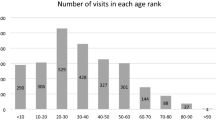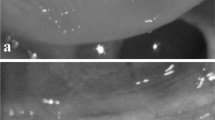Abstract
The literature about eye, ear, nose, skin, and nervous system disorders in women with Turner syndrome is equivocal. Impaired vision and hearing in women with Turner syndrome have been described, and case reports of Turner syndrome girls suffering from epilepsy have been published, but no large population-based-studies have explored the occurrence of any of these disorders. We aimed to investigate the risk of admission with disorders related to the eye, ear, nose, skin, and nervous system, compared with background females, and the impact of hormone replacement therapy on these conditions. 1,156 females with TS diagnosed during 1960–2014 were identified using the Danish Cytogenetic Central Registry and linked with personal-level data from the National Patient Registry and the Medication Statistics Registry. Statistics Denmark randomly identified 115,577 age-matched background females. Negative binomial regression was used to analyze hospital discharge diagnoses, reporting incidence rate ratios (IRR). Women with Turner syndrome have an increased risk of developing eye disorders (IRR 4.3 (95% CI 3.5–5.4), including cataract, glaucoma, ocular movement, and accommodation. The risk of ear disorders (IRR 35.0 (27.9–43.9)) and nose (IRR 2.2 (1.4–3.6)) was increased in women with Turner syndrome, due to otitis media, cholesteatoma, and hearing loss. Disorders of the nervous system such as epilepsy were increased IRR 6.2 (2.4–15.9), along with skin conditions IRR 2.2 (95%CI 1.7–2.7) like psoriasis, atopic dermatitis, and ingrown nails.
This is a preview of subscription content, access via your institution
Access options
Subscribe to this journal
Receive 12 print issues and online access
$259.00 per year
only $21.58 per issue
Buy this article
- Purchase on SpringerLink
- Instant access to full article PDF
Prices may be subject to local taxes which are calculated during checkout


Similar content being viewed by others
Data availability
Restrictions apply to the availability of data analyzed during this study to preserve patient confidentiality. All analyzed of data in this study was performed through a remote access to Statistic Denmark (https://www.dst.dk/en/). Researchers can apply Statistics Denmark in order to access the registry data. The corresponding author will on request detail the restrictions and any conditions under which access to some data may be provided.
References
Gravholt CH, Andersen NH, Conway GS, Dekkers OM, Geffner ME, Klein KO, et al. Clinical practice guidelines for the care of girls and women with Turner syndrome: proceedings from the 2016 Cincinnati International Turner Syndrome Meeting. Eur J Endocrinol. 2017;177:G1–G70.
Gravholt CH, Juul S, Naeraa RW, Hansen J. Morbidity in Turner Syndrome. J Clin Epidemiol. 1998;51:147–58.
Viuff MH, Berglund A, Juul S, Andersen NH, Stochholm K, Gravholt CH. Sex hormone replacement therapy in turner syndrome: impact on morbidity and mortality. J Clin Endocrinol Metab. 2020;105:468–78.
Viuff MH, Stochholm K, Grønbaek H, Berglund A, Juul S, Gravholt CH. Increased occurrence of liver and gastrointestinal diseases and anaemia in women with Turner syndrome — a nationwide cohort study. Aliment Pharm Ther. 2021;53:821–9.
Gravholt CH, Viuff MH, Brun S, Stochholm K, Andersen NH. Turner syndrome: mechanisms and management. Nat Rev Endocrinol. 2019;15:601–14.
Gravholt CH, Naeraa RW, Nyholm B, Gerdes LU, Christiansen E, Schmitz O, et al. Glucose metabolism, lipid metabolism, and cardiovascular risk factors in adult Turner’s syndrome: the impact of sex hormone replacement. Diabetes Care. 1998;21:1062–70.
Hultcrantz M, Sylvén L. Turner’s syndrome and hearing disorders in women aged 16-34. Hear Res. 1997;103:69–74.
Roush J, Davenport ML, Carlson-Smith C. Early-onset sensorineural hearing loss in a child with Turner syndrome. J Am Acad Audio. 2000;11:446–53.
Bonnard Å, Bark R, Hederstierna C. Clinical update on sensorineural hearing loss in Turner syndrome and the X-chromosome. Am J Med Genet C Semin Med Genet. 2019;181:18–24.
Barrenäs ML, Nylén O, Hanson C. The influence of karyotype on the auricle, otitis media and hearing in Turner syndrome. Hear Res. 1999;138:163–70.
Bois E, Nassar M, Zenaty D, Léger J, Van Den Abbeele T, Teissier N. Otologic disorders in Turner syndrome. Eur Ann Otorhinolaryngol Head Neck Dis. 2018;135:21–24.
Wikiera B, Mulak M, Koltowska-Haggstrom M, Noczynska A. The presence of eye defects in patients with Turner syndrome is irrespective of their karyotype. Clin Endocrinol (Oxf). 2015;83:842–8.
Lowenstein EJ, Kim KH, Glick SA. Turner’s syndrome in dermatology. J Am Acad Dermatol. 2004;50:767–76.
Jørgensen KT, Rostgaard K, Bache I, Biggar RJ, Nielsen NM, Tommerup N, et al. Autoimmune diseases in women with Turner’s syndrome. Arthritis Rheumatism. 2010;62:658–66.
Hutaff-Lee C, Bennett E, Howell S, Tartaglia N. Clinical developmental, neuropsychological, and social-emotional features of Turner syndrome. Am J Med Genet Part C, Semin Med Genet. 2019;181:126–34.
Turner MR, Goldacre R, Ramagopalan S, Talbot K, Goldacre MJ. Autoimmune disease preceding amyotrophic lateral sclerosis: an epidemiologic study. Neurology. 2013;81:1222–5.
Jhang KM, Chang TM, Chen M, Liu CS. Generalized epilepsy in a patient with mosaic Turner syndrome: a case report. J Med Case Rep. 2014;8:109.
Akasaka M, Kamei A, Ito J, Oyama K. Turner syndrome associated with refractory seizures and intellectual disability: a case study. Cureus. 2020;12:e11364.
Viuff MH, Stochholm K, Lin A, Berglund A, Juul S, Gravholt CH. Cancer occurrence in Turner syndrome and the effect of sex hormone substitution therapy. Eur J Endocrinol. 2021;184:79–88.
Schmidt M, Schmidt SA, Sandegaard JL, Ehrenstein V, Pedersen L, Sorensen HT. The Danish National Patient Registry: a review of content, data quality, and research potential. Clin Epidemiol. 2015;7:449–90.
Kildemoes HW, Sorensen HT, Hallas J. The Danish national prescription registry. Scand J public health. 2011;39:38–41.
Laura DM, Yannuzzi NA, Prakhunhungsit S, Berrocal AM. Select pediatric vitreoretinal disease in the setting of Turner’s syndrome. Am J Ophthalmol Case Rep. 2020;18:100662.
Chrousos GA, Ross JL, Chrousos G, Chu FC, Kenigsberg D, Cutler G Jr, et al. Ocular findings in Turner syndrome. A prospective study. Ophthalmology. 1984;91:926–8.
Beby F, Roche O, Burillon C, Denis P. Coats’ disease and bilateral cataract in a child with Turner syndrome: a case report. Graefes Arch Clin Exp Ophthalmol. 2005;243:1291–3.
Denniston AK, Butler L. Ophthalmic features of Turner’s syndrome. Eye (Lond). 2004;18:680–4.
Noma T, Kanai Y, Kanai-Azuma M, Ishii M, Fujisawa M, Kurohmaru M, et al. Stage- and sex-dependent expressions of Usp9x, an X-linked mouse ortholog of Drosophila Fat facets, during gonadal development and oogenesis in mice. Gene Expr Patterns. 2002;2:87–91.
Johnson BV, Kumar R, Oishi S, Alexander S, Kasherman M, Vega MS, et al. Partial loss of USP9X function leads to a male neurodevelopmental and behavioral disorder converging on transforming growth factor β signaling. Biol Psychiatry. 2020;87:100–12.
Homan CC, Kumar R, Nguyen LS, Haan E, Raymond FL, Abidi F, et al. Mutations in USP9X are associated with X-linked intellectual disability and disrupt neuronal cell migration and growth. Am J Hum Genet. 2014;94:470–8.
Paemka L, Mahajan VB, Ehaideb SN, Skeie JM, Tan MC, Wu S, et al. Seizures are regulated by ubiquitin-specific peptidase 9 X-linked (USP9X), a De-Ubiquitinase. PLOS Genet. 2015;11:e1005022.
Alves C, Oliveira CS. Hearing loss among patients with Turner’s syndrome: literature review. Braz J Otorhinolaryngol. 2014;80:257–63.
Lim D, Hassani S, Lupton K, Gault EJ, Wynne D, Clement W, et al. Prevalence, risk factors and management strategies for otological problems in girls with Turner syndrome. Acta Paediatr. 2020;109:2075–83.
Kubba H, McAllister K, Hunter K, Mason A. Annual hearing screening in girls with Turner Syndrome: results from the first three years in Glasgow. Int J Pediatr Otorhinolaryngol. 2019;120:152–6.
Lim DB, Gault EJ, Kubba H, Morrissey MS, Wynne DM, Donaldson MD. Cholesteatoma has a high prevalence in Turner syndrome, highlighting the need for earlier diagnosis and the potential benefits of otoscopy training for paediatricians. Acta Paediatr. 2014;103:e282–287.
Cameron-Pimblett A, La Rosa C, King TFJ, Davies MC, Conway GS. The Turner syndrome life course project: Karyotype-phenotype analyses across the lifespan. Clin Endocrinol (Oxf). 2017;87:532–8.
Álvarez-Nava F, Racines-Orbe M, Witt J, Guarderas J, Vicuña Y, Estévez M, et al. Metabolic syndrome as a risk factor for sensorineural hearing loss in adult patients with Turner Syndrome. Appl Clin Genet. 2020;13:25–35.
Choi SH, Han MY, Ahn YM, Park YM, Kim CK, Kim HH, et al. Predisposing factors associated with chronic and recurrent rhinosinusitis in childhood. Allergy Asthma Immunol Res. 2012;4:80–84.
Rosina P, Segalla G, Magnanini M, Chieregato C, Barba A. Turner’s syndrome associated with psoriasis and alopecia areata. J Eur Acad Dermatol Venereol. 2003;17:50–52.
Watabe H, Kawakami T, Kimura S, Fujimoto M, Ono T, Mizoguchi M, et al. Childhood psoriasis associated with Turner syndrome. J Dermatol. 2006;33:896–8.
Oiso N, Ota T, Kawara S, Kawada A. Pustular psoriasis and vitiligo in a patient with Turner syndrome. J Dermatol. 2007;34:727–9.
Kato Y, Kanazawa N, Yamamoto T. Pediatric pustular psoriasis with Turner’s syndrome. J Dermatol. 2015;42:1208–9.
Shiratori T, Takeichi T, Kono M, Nishida M, Imanishi A, Maekawa N, et al. A case of pustular psoriasis possibly precipitated by periodic oestrogen/gestagen therapy for Turner syndrome. Clin Exp Dermatol. 2019;44:e240–e241.
Egger A, Maderal A, Lev-Tov H, Stojadinovic O. A case report of a patient with turner syndrome, multiple comorbidities, and pustular psoriasis: correlation or coincidence? Case Rep. Dermatol Med. 2020;2020:5750309.
Liang Y, Sarkar MK, Tsoi LC, Gudjonsson JE. Psoriasis: a mixed autoimmune and autoinflammatory disease. Curr Opin Immunol. 2017;49:1–8.
Kamiya K, Kishimoto M, Sugai J, Komine M, Ohtsuki M. Risk factors for the development of psoriasis. Int J Mol Sci. 2019;20:4347.
Bakalov VK, Gutin L, Cheng CM, Zhou J, Sheth P, Shah K, et al. Autoimmune disorders in women with turner syndrome and women with karyotypically normal primary ovarian insufficiency. J Autoimmun. 2012;38:315–21.
Trolle C, Nielsen MM, Skakkebaek A, Lamy P, Vang S, Hedegaard J, et al. Widespread DNA hypomethylation and differential gene expression in Turner syndrome. Sci Rep. 2016;6:34220.
Hultcrantz M, Simonoska R, Stenberg AE. Estrogen and hearing: a summary of recent investigations. Acta Otolaryngol. 2006;126:10–14.
Acknowledgements
Jan Hansen from the Danish Cytogenetic Central Register is thanked for the identification of women with Turner syndrome. Statistics Denmark supplied the data and identified controls.
Funding
This work was supported by Aarhus University (PhD grant) to Mette Viuff; the Novo Nordisk Foundation (NNF13OC0003234, NNF15OC0016474), the Independent Research Fund Denmark (0134-00406 A); and the Familien Hede Nielsen foundation.
Author information
Authors and Affiliations
Contributions
MV and CG developed the theory and hypotheses. MV retrieved data from the registries and analyzed data. SJ and MV developed the final methods. All authors discussed the results and contributed to the final manuscript. MV wrote the manuscript with support from CG, SJ and KS. All authors approved the final version of the article, including the authorship list.
Corresponding author
Ethics declarations
Competing interests
The authors declare no competing interests.
Ethical approval
The board of the Danish Cytogenetic Central Registry and the Danish Data Protection Authority approved the project with the registration number 2013-41-2017. Data were accessed using a secure remote access to Statistics Denmark. In order to avoid any possibility of personal identification of cases, Statistics Denmark prohibits specification of the exact number of cases with a given condition if less than four, and we therefore report these as “<4”.
Additional information
Publisher’s note Springer Nature remains neutral with regard to jurisdictional claims in published maps and institutional affiliations.
Rights and permissions
About this article
Cite this article
Viuff, M.H., Stochholm, K., Juul, S. et al. Disorders of the eye, ear, skin, and nervous system in women with Turner syndrome –a nationwide cohort study. Eur J Hum Genet 30, 229–236 (2022). https://doi.org/10.1038/s41431-021-00989-5
Received:
Revised:
Accepted:
Published:
Issue date:
DOI: https://doi.org/10.1038/s41431-021-00989-5
This article is cited by
-
Elevated levels of neutrophils with a pro-inflammatory profile in Turner syndrome across karyotypes
npj Genomic Medicine (2025)
-
X chromosome dosage and the genetic impact across human tissues
Genome Medicine (2023)
-
2021 at European Journal of Human Genetics: the year in review
European Journal of Human Genetics (2022)



